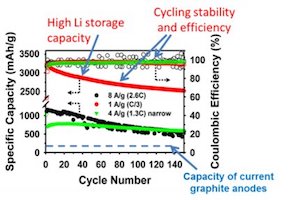Smartphones Batteries That Last Twice as Long to Arrive Soon
Posted date: : March 3, 2013
 Late last year, researchers at Argonne National Laboratory and Northwestern University, both in Illinois, touted new technology that could double or triple the battery life of smartphones. Now, a Los Angeles, California-based start-up is bringing the new technology to the market.
Late last year, researchers at Argonne National Laboratory and Northwestern University, both in Illinois, touted new technology that could double or triple the battery life of smartphones. Now, a Los Angeles, California-based start-up is bringing the new technology to the market.Lithium-ion batteries, which are common in portable electronic devices, use graphite as anode material, but the large aspect ratio of the graphitic sheets limits the speed at which lithium can be inserted to the structure. In a paper titled “Flexible Holey Graphene Paper Electrodes with Enhanced Rate Capability for Energy Storage Applications”, researchers led by Northwestern’s Harold Kung explained that they have discovered a method to overcome this limitation by introducing nanometer-size vacancy defects (silicon nano particles) in the graphene sheets.
Working with Argonne for the past year, California Lithium Battery announced late last month test results showing the energy density increasing by the times and specific anode capacity by four times over existing lithium ion batteries. CalBattery says the superior results of its new GEN3 battery material suggest that anode materials using the breakthrough Argonne silicon-graphene process could eventually replace conventional graphite based anode materials used in most lithium-ion batteries manufactured today.
CalBattery is currently fast-tracking commercialization of Gen3, and aims to produce and sell its si-graphene anode material to global battery manufacturers in the next two years.
